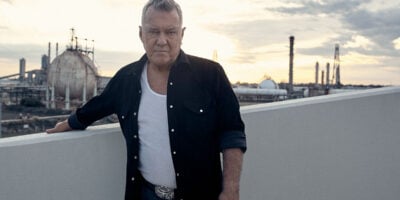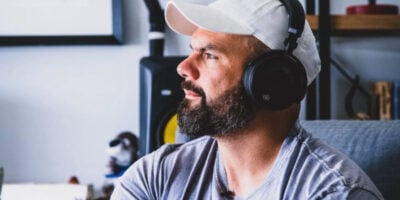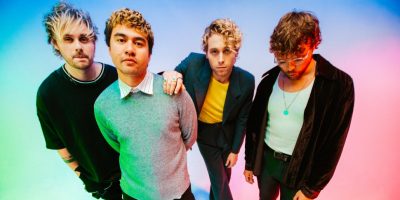Talented producer, multi-instrumentalist, and all-round polymath Paul Conrad is coming off a hugely successful 12 months, having nabbed deals with Island Records in the UK and Primary Talent, the home of Alt-J and Lana Del Rey.
He’s also toured Australia with the likes of Winterbourne and Eves the Behaviour, in addition to releasing plenty of new music, such as recent single ‘California’, which is out now via Dew Process/Universal Music Australia.
A classically trained orchestra musician, Conrad has spent the last few years becoming one of the internet’s most buzzed-about musicians, crafting a unique alt-pop concoction of hazy vocals, electronic beats, and booming choruses.
We recently caught up with the witty and articulate Conrad to talk about his approach to making music, songwriting, and equipment, in the process discovering the production gear that Paul Conrad couldn’t live without.
The Essentials
 It’s not as if I’m flying around in a private jet, so I’m usually limited or reduced to a car and I used to move furniture for a quid so I am rather adept at Tetris and strategic packing.
It’s not as if I’m flying around in a private jet, so I’m usually limited or reduced to a car and I used to move furniture for a quid so I am rather adept at Tetris and strategic packing.
However, with that being said, if I could only bring my essentials, I would take my Rickenbacker, Roland SPD Sampler & Roland JD-XI synth.
That’s all I need right now. And without them, it’s just me singing. And let me tell you, I wouldn’t subject even my worst enemies to that atrocity.
Evolution
I toured in an orchestra with a bassoon. Then I toured Australia in bands with just my guitar, amp, and pedals. Now for my solo shows I utilize the benefits of synths, samplers, and other things that diminish musical ineptitude.
Most people evolve. I have devolved into nothing more than a lazy pathetic faux musician. But hey, at least I’m blending in with all the other button pushing turkeys now.
Hitting The Studio
 I don’t use my Roland SPD in the studio as there is no need, but I suppose I would use my guitars and synths at various points. It would say it’s more or less a completely different realm.
I don’t use my Roland SPD in the studio as there is no need, but I suppose I would use my guitars and synths at various points. It would say it’s more or less a completely different realm.
Ultimately, I write a song on piano, construct it in the studio, then use what is created there to perform live – not the other way around.
Back In The Day
My first instrument was a clarinet. All I knew was that it made noise; an awful noise at that. My first bit of recording gear was a Zoom multi-track tape recorder, which was my first proper expedition into the realm of recording songs.
I was about 10 at the time and I remember it being a godsend because prior to that, in order to multi-track, I would have to record an idea onto cassette, then play that cassette loudly in the background on another player whilst recording another layer onto a fresh cassette.
This process would go on indefinitely and it was almost virtually like tape inception, an infinite regress of filtered tape recordings. I wouldn’t have the patience for that now. I’d sooner throw the tape player out the window before severing my own head.
Gear Vs Song
 The melodies and chords of the songs are written on piano or guitar in a really primitive form and are then developed in the studio utilizing the gear that I have so I suppose in a way yes the outcome of the song can be influenced by the gear but more so sonically than melodically.
The melodies and chords of the songs are written on piano or guitar in a really primitive form and are then developed in the studio utilizing the gear that I have so I suppose in a way yes the outcome of the song can be influenced by the gear but more so sonically than melodically.
The chords and melodies stem from what is in my head but then I suppose the way those chords and melodies manifest themselves will be determined by the nature of the gear.
Developing A Style
To be honest, at the end of the day, a song is a song and it’s what comes from your mind and how capable you are at playing. You could have gear that is absolute bat piss but if you know how to use it and you are creatively industrious, then you will do well and create something unique and special.
On the contrary, you can have all the best, most expensive and elaborate gear in the world, but if you’re a muppet, you will fail and inevitably end up with something that sounds like the auditory manifestation of a syphilitic rat.
I have a shitty old casio keyboard that is absolute tart fodder, but I just love the weird sounds it gets. I also have some incredibly woeful guitars, which I won’t even name, but they’re useful because I extract their potential and can actually play my instruments, which is an increasingly unusual trait to have as ‘musician’ these days.
I would never place too much emphasis on it, you have to write songs first and make sure you’re good at that. Then I suppose as time goes on you develop propensities towards certain toys and sounds which I guess naturally become part of your sound. It’s all cyclical, ever expansive & omnipotent.
Getting Weird
 I have an old Epiphone Les Paul guitar from the ’80s which some idiot has put a Bigsby tremolo bar on. Strange, but cool nonetheless. My folks also gave me an old marching drum and mandolin. I don’t use them much. They just sit in the studio and look cool. Sometimes, I hit people with them.
I have an old Epiphone Les Paul guitar from the ’80s which some idiot has put a Bigsby tremolo bar on. Strange, but cool nonetheless. My folks also gave me an old marching drum and mandolin. I don’t use them much. They just sit in the studio and look cool. Sometimes, I hit people with them.
I bought an old, 1980s organ for $10 bucks at auction. It’s awful and tacky but I get some really cool cheesy sounds from it.
My oldest piece of gear is an old Rickenbacker from the 70s and a PSK rack delay from the early ’80s. Actually, I have an antique Ronisch grand piano – beautiful sound, but good luck trying to tune the fucking thing.
Gear Rundown
This is a basic rundown of what inhabits my studio:
DAWs:
– Pro Tools
– Logic
– Reason
– Fucktonnes of plugins.
Interface:
– Universal Audio Apollo QUAD
– Apogee PSX Conversion
– Mackie Onyx summing
Preamps:
– Chandler TG-2 500 series pre
– Golden Age 573 500 series pre
– Presonus digimax pres
– UAD Apollo pres
– Mackie Onyx pres
Compressors:
– Universal Audio 1176 Fet Style Comp
– ADL 1000 tube optical compressor
– 500 series Purple Audio compressor
– IGS S-type stereo compressor
– IGS One LA-2A style compressor
EQ:
– API 500 series EQ
– Empirical Labs DoccDer 500 series tone shaper
– Antares AVP-1 Channel Strip
FX:
– T.C. Electronic G-major FX rack
– Lexicon MX200 Reverb Rack
– Peavey reverb & FX rack
– PSK 1980s delay rack
Mics:
– Beesneez Isobel condenser
– Advanced Audio CM-87 condenser
– Shure SM-57
– Shure SM-58
– Rode NT1A condenser mic
– Shure kick, snare & tom mics
– Pair Samson pencil condensers
– CAD GLX2200 condenser
– Rode K2 condensor
Guitars:
– Gibson 137
– Gibson SG
– Rickenbacker 330
– Rickenbacker 620
– Epiphone Dot
– Epiphone Les Paul
– Taylor T5 electric acoustic
– ESP M-10
Bass:
– Squire P-bass
– Another Squire P-bass
– ESP 5 string
Amps:
– Fender White Lightning Hot Rod
– Mesa Boogie
– Behringer bass head/ashdown 4X10 cab
– Zoom multi-FX combo amp
– Orange tiny terror combo amp
Pedals:
– Electro-harmonix Big muff
– Boss DS-1
– Jekyl & hyde overdrive/distortion
– Ibanez tube-screamer
– Danelectro Cool Cat Chorus
– Electro harmonix memory toy
– Electro harmonix cathedral reverb
– Boss DD-7 digital delay
– Xvive Blue chorus vibrato pedal
– Xvive Yellow lemon squeezer compressor
– Electro harmonix cathedral reverb
– Moen Fuzz Moo
– M.I. Audio Fuzz
– Joyo Octave Fuzz
– Joyo Tremelo
– Joyo vintage overdrive
Pianos/Synths/Samplers:
– Antique Ronisch grand piano
– C. Schwerten [Berlin] antique upright paino
– Roland JD-XI
– 1980s Yamaha Synth patchbox
– Roland SPD Sampler pad
– Roland 300 Electric piano
– Roland XP-10
– Vintage casio synth
– ELKA vintage organ
– Andante vintage organ
Solving Problems
I never really encounter problems, but the IGS S-type stereo compressor I use on the mix bus is phenomenal. You could run a dead badger through it and it would create something audibly pleasing. I also use J-37 Waves tape & UAD ATG-102 tape plugs on pretty much everything. Lifesavers.
Paul Conrad’s latest single ‘California’ is out now via Dew Process, for more info on upcoming shows or releases visit www.thepaulconrad.com

































